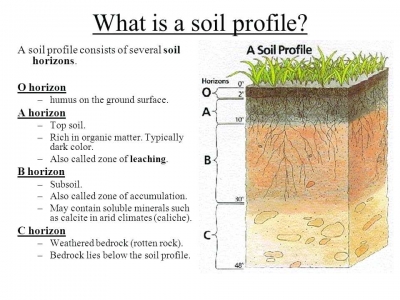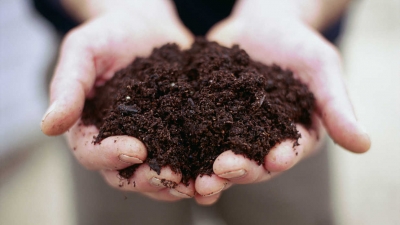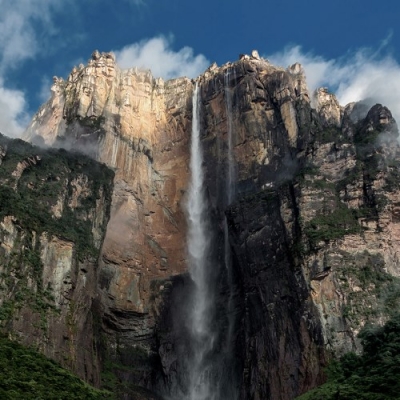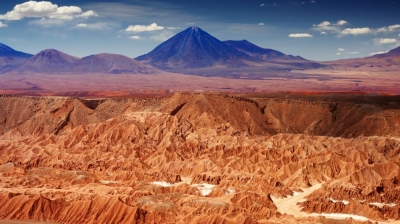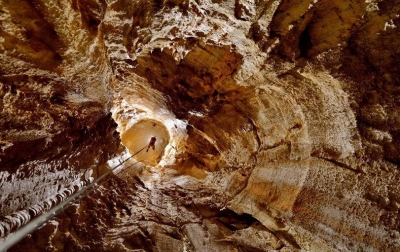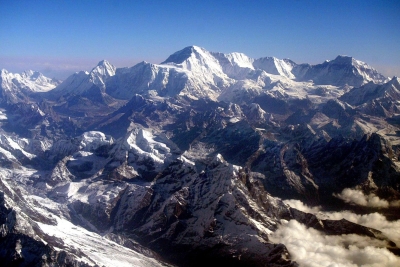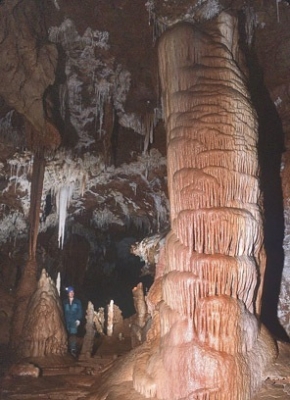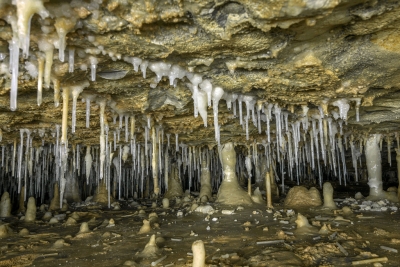
Rocks go through many changes over time. These are caused by different processes, such as heating, cooling, and weathering. The sequence of changes is called the rock cycle.
Igneous rock:
Igneous rocks form by the cooling of magma (molten rock material beneath the surface) or lava (molten rock material extruded onto the surface). Magma which originates at depths as great as 200 kilometers below the surface consists primarily of elements found in silicate minerals along with gases, notably water vapor. Because the molten material is less dense than the surrounding solidified rock, it works its way toward the surface where it flows out onto the surface as lava.
Cooling:
What would you do to turn a melted chocolate bar back into a solid? You’d cool it by putting it into the refrigerator until it hardens.
Similarly, liquid magma also turns into a solid — a rock — when it is cooled. Any rock that forms from the cooling of magma is an igneous rock. Magma that cools quickly forms one kind of igneous rock, and magma that cools slowly forms another kind.
When magma rises from deep within the earth and explodes out of a volcano, it is called lava, and it cools quickly on the surface. Rock formed in this way is called extrusive igneous rock. It is extruded, or pushed, out of the earth’s interior and cools outside of or very near the earth’s surface.
What if the magma doesn’t erupt out of a volcano, but instead gets pushed slowly upward toward the earth’s surface over hundreds, thousands, or even millions of years? This magma will also cool, but at a much slower rate than lava erupting from a volcano. The kind of rock formed in this way is called intrusive igneous rock. It intrudes, or pushes, into the earth’s interior and cools beneath the surface.
Melting:
What happens to a chocolate bar when it gets very hot? It melts.
The same thing happens to a rock when it is heated enough. Of course, it takes a lot of heat to melt a rock. The high temperatures required are generally found only deep within the earth. The rock is pulled down by movements in the earth’s crust and gets hotter and hotter as it goes deeper. It takes temperatures between 600 and 1,300 degrees Celsius (1,100 and 2,400 degrees Fahrenheit) to melt a rock, turning it into a substance called magma (molten rock).
Metamorphic rock:
Metamorphic rocks are formed by the alteration of pre-existing rocks from exposure to heat and pressure while remaining in a solid form. Metamorphism occurs by breaking bonds between atoms in a mineral so that the atoms rearrange themselves into new, more stable, mineral forms. Rocks are transformed and remain in a solid state because not all the bonds in the rock’s minerals are broken – if they were the rock would melt. Metamorphism occurs in solid rock because only some of the bonds between atoms are broken in an unstable mineral. As a result, the freed atoms and ions can migrate to another location within the mineral, or bond with atoms in a different mineral. The end result is to produce minerals that are more stable under the environmental conditions in which they exist.
Metamorphism involves the transformation of a pre-existing rock to form new minerals and textures. The original mineral content of a rock can change in several ways. Unstable minerals like clay will breakdown and their elements will recombine to form new minerals. More stable minerals like quartz, will stay quartz but change shape and size to form a new configuration. At high temperatures, atoms and ions may move into a new orientation and bond into more stable forms. Hence, the type of minerals and its texture may change but the chemical composition of the rock itself can stay the same.
Uplift:
Understanding the idea of Uplift is the key to making sense of the rock cycle, as it allows us to see rocks that were once deeply buried beneath the surface.
If rocks did not get uplifted to form hills and mountains, then the processes of weathering and erosion would long ago have reduced much of the world’s land-masses to low-lying, flat plains. Weathering and erosion, transport and deposition would all effectively stop.
Scientists believe that, if all these active processes of the rock cycle ceased to operate, then our planet would cease to be able to support any life.
Mount Everest is made of limestone that must have originally formed on an ancient sea floor because it contains fossils of marine creatures.
Heat and Pressure:
The atoms in rocks rearrange to form bigger and heavier minerals. The combination of heat and pressure may cause the minerals in the rock to split into layers. Metamorphic rocks begin changing at temperatures of 100 degrees Celsius to 800 degrees Celsius. If you squeeze and heat a rock for a few million years, it can turn into a new kind of rock.
The pressure comes from many layers of rock piling on top of each other, and the heat comes from magma. It’s like putting blankets on yourself – the more you layers you put on, or the more blankets you put on, the more pressure you receive because of all the weight of the layers on top of you.
Sedimentary rock:
Sedimentary rocks are those formed from the compaction and cementation of fragments of pre-existing rocks called clasts, or plant and animals remains. The exogenic processes of weathering and erosion create the raw materials for sedimentary rocks. Earth material is loosened and moved from higher to lower elevations where it is deposited as transportation agents like water, wind or gravity lose their energy to move sediment. Streams and rivers transport sediment to lakes or oceans, or deposits it on nearby floodplains where it accumulates. On land, clastic sediments consist mainly of large boulders, cobbles, gravel, sand, and silt. On the continental shelves at the margin of continents, marine sediment is largely sand, silt, and clay. At the outer shelves and on the ocean floor, clays and chemically precipitated calcium carbonate and the remains of tiny marine animals accumulate.
Weathering and erosion:
Rocks are hard and strong, but they do not stay that way forever. Forces like wind and water break down rocks through the processes of weathering and erosion.
Weathering is the process that breaks down rocks. Many things cause weathering, including climate changes. Erosion breaks rocks down further and then moves them. Forces like wind and water move the rock pieces. They mix with matter like sand to become sediment. Weathering and erosion help shape Earth’s surface. They are part of a process called the rock cycle.
Transportation and deposition:
Eroded rock particles are carried away by wind or by rain, streams, rivers, and oceans. As rivers get deeper or flow into the ocean, their current slows down, and the rock particles (mixed with soil) sink and become a layer of sediment. Often the sediment builds up faster than it can be washed away, creating little islands and forcing the river to break up into many channels in a delta.
Sedimentation and cementation:
Cementation, in geology, hardening and welding of clastic sediments (those formed from preexisting rock fragments) by the precipitation of mineral matter in the pore spaces. It is the last stage in the formation of a sedimentary rock. The cement forms an integral and important part of the rock, and its precipitation affects the porosity and permeability of the rock. Many minerals may become cements; the most common is silica (generally quartz), but calcite and other carbonates also undergo the process, as well as iron oxides, barite, anhydrite, zeolites, and clay minerals.
Picture Credit : Google


